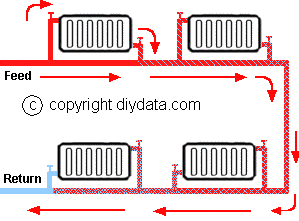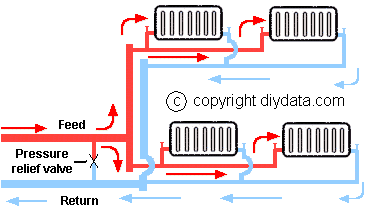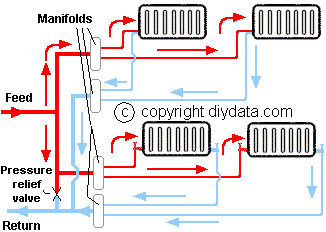Water Central Heating
the pipework
single pipe - feed and return - micro bore
A water central heating system consists of basically the boiler, the radiators and the interconnecting piping.
The boiler heats the water and (normally) a pump circulates the water through the pipework and radiators and back to the boiler.
There are a number of different arrangements of boiler, pipework and supply to the radiators; each systems has its own advantages and drawbacks.
This page explains the circulation pipework, refer to the related pages (see to the right) for other parts of the system.
Pipework
There are 3 basic arrangements for the pipework connecting the boiler to the radiators:
- Single pipe loop
- Feed and return pipes
- Micro bore
General practice is for the pipework to be installed below the radiator. With suspended timber floors, this is no great problem as the pipes can be installed below the floorboards with the risers to each radiator passing through holes in the floorboards. The pipework is normally either run between the joists or across the joists through cut-outs cut in the top of the joists. Except for microbore, the pipework should be supported below the floor boards to avoid excessive weight having to be supported by the pipework itself.
This method of installation is impractical where the building uses solid floors. Such installations normally have high level feed pipes with fall pipes feeding single or adjacent radiators. Where the ceiling of the room is suspended, the pipework is normally installed between the joists of the ceiling from above, this may not be possible where each floor is a separate dwelling.
A third alternative is to run the feed pipes around the top of the wall just below the ceiling with fall pipes. It is never really desirable to run the feed pipes at floor level, problems arise where the pipes have to cross doorways,although the pipes could be taken up and around the door frame or be buried under the floor.
Where high level feed pipes need to be installed in a loft, the pipework must in insulated. It is not normally considered necessary to insulate pipework below suspended floors however there is potentially (general small) scope for energy conservation if it were to be.
Where the level of the circulating pipework is above the radiators, the pipework needs to incorporate bleed valves to allow any air in the system to be released.
Single pipe loop
 A single pipe loop arrangement has, as the name implies, a single loop of pipework running from the boiler and returning to the boiler. Each radiator 'sits' upon the pipe with both radiator connections made to the same pipe. As the heated water from the boiler is fed along the pipe, natural convection (hot water rises) causes the heated water to rise into the radiator displacing cooler water back into the pipe.
A single pipe loop arrangement has, as the name implies, a single loop of pipework running from the boiler and returning to the boiler. Each radiator 'sits' upon the pipe with both radiator connections made to the same pipe. As the heated water from the boiler is fed along the pipe, natural convection (hot water rises) causes the heated water to rise into the radiator displacing cooler water back into the pipe.
A major disadvantage of this arrangement is that the first radiator gets hotter than the second one etc. and the last radiator will be considerable cooler as the water will have given up most of its heat to the previous radiators along the pipe run.
In principal the number of radiators which can be fitted to a single pipe loop is unlimited, but the more radiators fitted, the greater the cooling between the first and last radiators.
These systems are often used in industrial buildings where the loop pipe may be extremely large, the systems can still be found in older domestic premises but they are generally old installation and are not considered efficient.
Feed and return pipes.

This system is more efficient than the single pipe loop. The heated water from the boiler is fed to one side of every radiator (the feed pipe) while the other end of each radiator is connected to a separate common return pipe. This means that the temperature of the water entering each radiator is more or less the same so each radiator should heat the local environment by the same amount.
A pressure relief valve (or automatic by-pass valve) is connected between the feed and return pipes, this allows the pump to circulated the water from the boiler if all the radiators should be shut off.
Because of the restriction of flow imposed by the radiators, the number of radiators is limited basically by the size of circulating pump. A standard pump for domestic use will probably be able to supply up to 12 radiators.
Another limitation is caused by the size of the pipework - normally the main pipes to and from the boiler are large (at least 22mm) and smaller pipework (15mm) is branched off to feed a number of radiators. The number of radiators which can be fed through these 15mm pipes will depend upon the length of the 15mm pipe runs - the longer the run, the fewer radiators. The illustration above shows two branches each feeding two radiators.
Micro Bore pipework
 The
micro bore system uses normal pipework for the feed from the boiler to manifolds and from manifolds back to the boiler on the return side. From each manifold, small pipework (normally 8mm) is connected to a number of radiators. The pipework between the manifolds and each radiator is normally kept below 5 metres.
The
micro bore system uses normal pipework for the feed from the boiler to manifolds and from manifolds back to the boiler on the return side. From each manifold, small pipework (normally 8mm) is connected to a number of radiators. The pipework between the manifolds and each radiator is normally kept below 5 metres.
Special radiator fitting may be used so that both the feed and return micro bore pipes are connected to the same end of each radiator (as upper 2 radiators in the illustration). Alternatively, the pipework may feed into into the two ends of the radiators (as lower 2 radiators in the illustration).
Again, there is a pressure relief valve (or automatic by-pass valve) between the boiler feed and return pipes to protect the boiler should all the radiators be turned off.
The advantage of the micro bore system is that the smaller pipes contain less water so less heat is lost along each pipe run. In addition, the micro bore pipework can be easily bent during installation and does not require the same number of joints.
The disadvantages are than being very small, the pipes can easily become blocked due to internal sediment and the pump needs to overcome increased resistance when circulating the water from the boiler so the pump is more prone to wear.
In hard water areas, lime scale can build-up in any circulating pipework, this especially effects micro bore circulation systems and a suitable additive or water softening device is essential.
